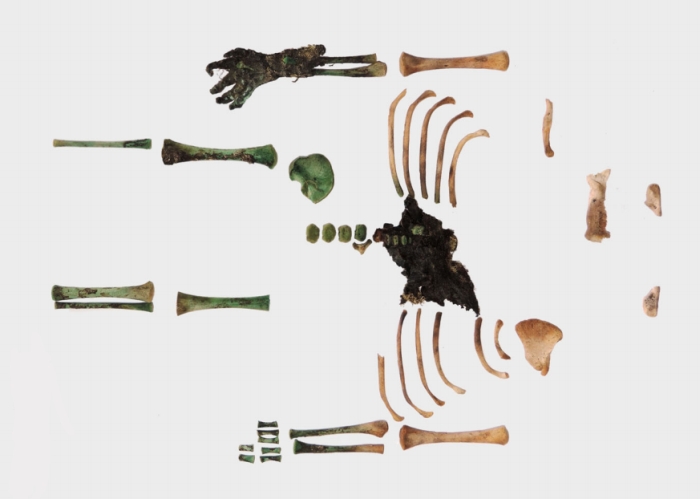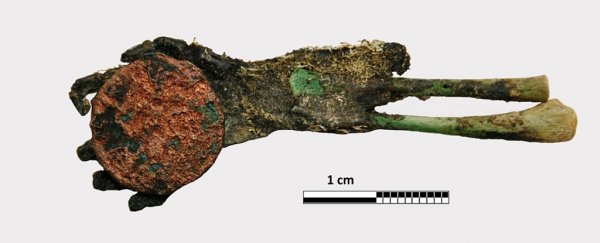In 2005, scientists were finally getting around to examining boxed remains from an earlier excavation of a medieval cemetery in Nyárlőrinc, Hungary, when they came across something really strange. The tiny hand of an infant, mummified, and tinged a curious shade of green.
It was only after finding the rest of the puzzle pieces and putting them together that biologist János Balázs of the University of Szeged and colleagues figured they had found a rarely reported mummification process - through copper.
The culprit was a coin that had been placed in the baby's hand, perhaps for its journey to the afterlife.
Finding green bones isn't uncommon. Copper jewelry and other adornments can cause skeletal discolouration as the oxidised metal leaches into the bones. A large portion of the infant's tiny skeleton - so small it must have been born prematurely, and died not long before or after birth - was tinged green, so the likelihood it had been buried with copper or bronze was pretty high.
A chemical analysis of the bones confirmed unusually high copper levels - nearly 500 times the normal concentration. But it wasn't clear why the levels were so high, not to mention the mysterious mummification of just one hand.
Then the researchers learned that other objects from the same dig were being housed at another, nearby museum. It was in one of those boxes that the rest of the pieces turned up - a ceramic pot, commonly used for what are known as "pot burials," and a corroded copper coin that fit perfectly into the tiny hand.
 (Balázs et al./Archaeological and Anthropological Sciences)
(Balázs et al./Archaeological and Anthropological Sciences)
And thus a sad tale emerges.
"According to ethnographic references, newborns who died without being baptised were rolled up in some sort of textile and buried in a pot (for example a milk-jug) or a small wooden box in abandoned cemeteries usually located close to ruins of medieval churches," the researchers wrote in their paper in 2016.
"Occasionally, low-value coins were put next to the body as offerings; the coins were intended to facilitate the soul's admission to heaven or served to pay the fee on the way to the underworld or Saint John the Baptist for christening the deceased in heaven."
Although this practice had never been documented before in Hungary - this case marks the first known - the explanation solves another mystery.
Most of the bones in the cemetery are dated from around 1200 to around 1600 CE. However, the coin placed in the baby's hand wasn't in use until 1858 - around 150 years after the cemetery had been abandoned.
As for how the hand was mummified, copper is well known for its antimicrobial properties, and it's likely that this is what caused the mummification.
It's not a sure answer; the researchers turned up another infant's remains, also buried with a copper coin, in which no mummification had occurred.
But it could explain some other archaeological mysteries - such as that of a mysterious burial site found in Siberia last year, where several bodies had been found "accidentally" mummified, sheathed in copper.
In fact, all the way back in 1888, Frederic Ward Putnam of the Peabody Museum at Harvard University reported a case in which a Native American's brain had been mummified via copper.
"Over the head was a broad piece of copper, extending from ear to ear, and over this a woven net of bark-fiber, outside of which was a braided mat of cedar bark," he wrote.
"The action of the copper upon these fabrics and upon the scalp has preserved them, and also the hair and skin under the copper. The bones of the face and portions of the cranium are deeply stained by the copper.
"Even the interior of the cranium is stained green, and the action of the copper, with the favourable condition of a dry soil, has preserved a portion of the brain mass with its membranes in the form of a hard dark ball."
And in 2016, it was determined that a copper belt had played a role in mummifying a single lung in the corpse of 6th century Merovingian Queen Arnegunde.
Whoever the infant's parents were, their loving gesture has echoed down the years.
"They kind of succeeded at saving not necessarily the soul, but some kind of legacy of this little kid," anthropologist Zsolt Bereczki told the New York Times, "because here we are still talking about the baby and the circumstances of its burial 150 years later."
The team's research was published in the journal Archaeological and Anthropological Sciences, and the remains are currently on display at the Móra Ferenc Museum in Szeged, Hungary.
